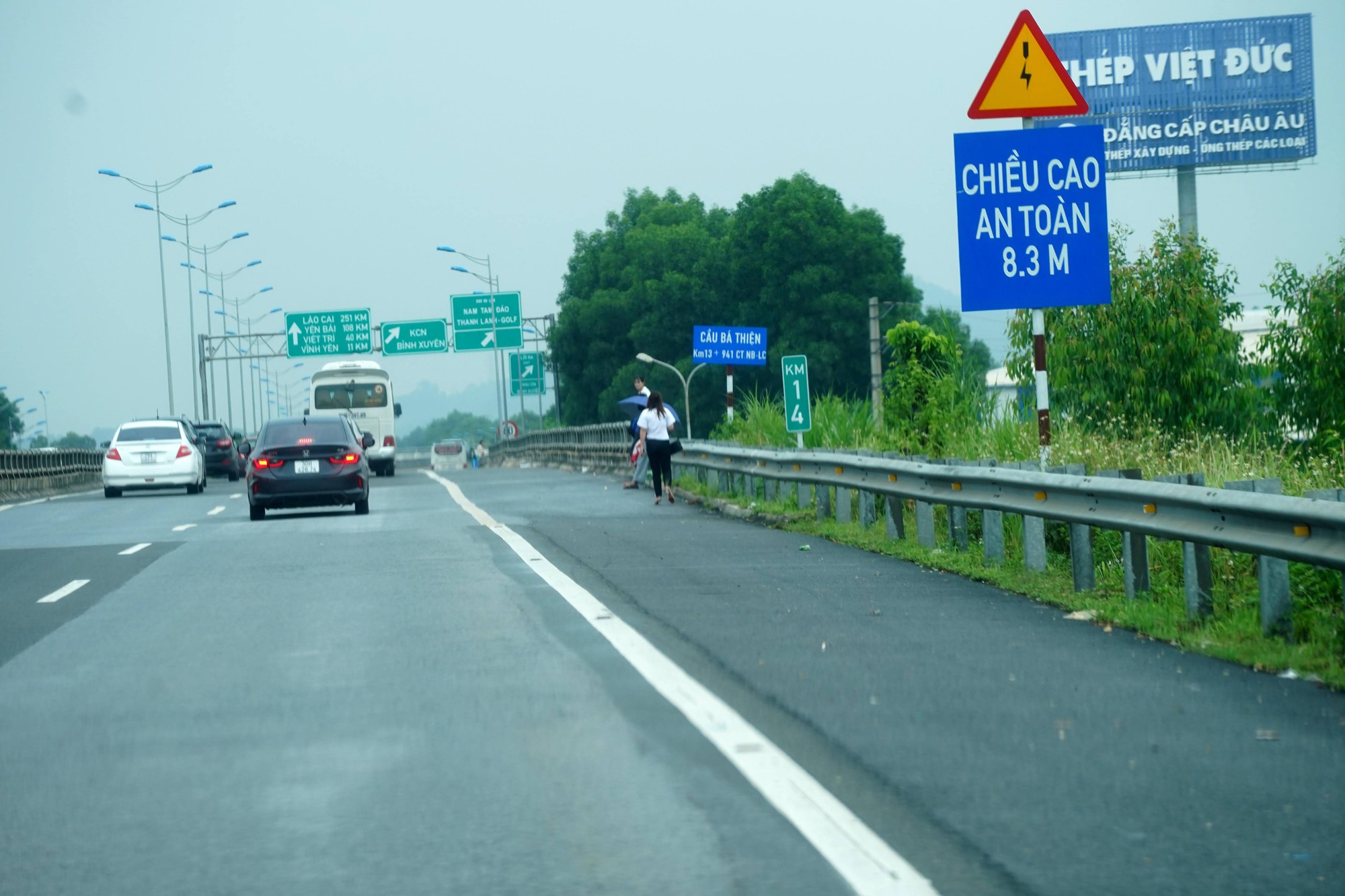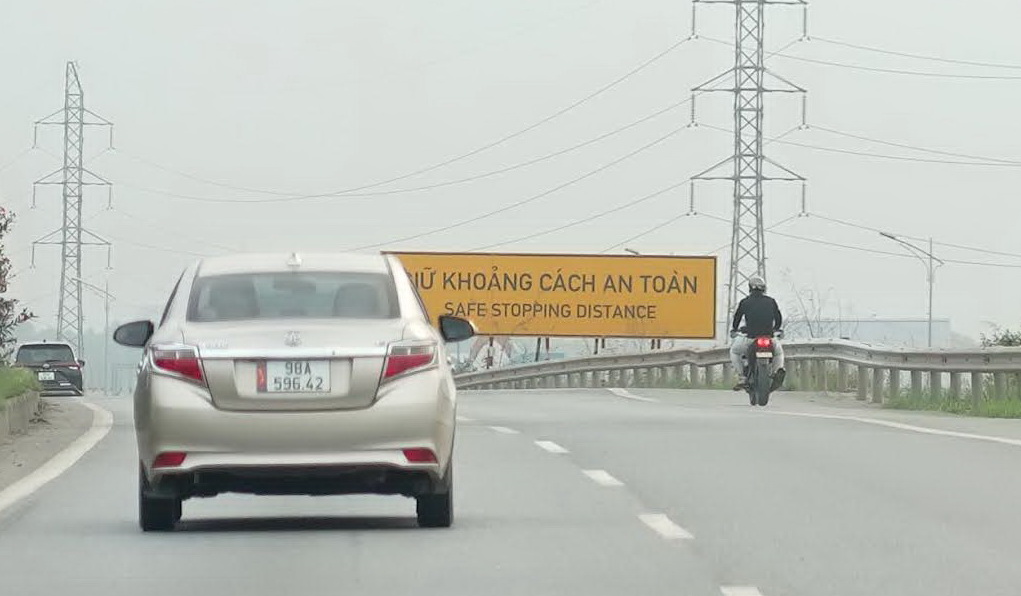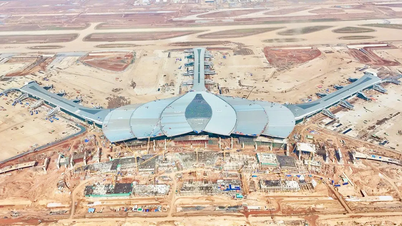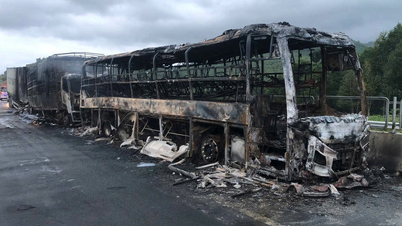From pedestrians to... stray cattle.
Not only are the infrastructure projects insufficient and small, but a major reason for the severe traffic congestion on expressways is the lack of synchronization between connecting projects. For example, the bottleneck of the Ho Chi Minh City - Long Thanh - Dau Giay (HLD) expressway for many years has been the An Phu interchange (Thu Duc City, Ho Chi Minh City) and the interchange with National Highway 51. The density of cars and container trucks turning onto the expressway is very high, but the roundabout at the interchange with the expressway is small. The narrow access road to the expressway leads to traffic conflicts between vehicles traveling from Bien Hoa to Vung Tau and those turning onto the expressway towards Ho Chi Minh City from Vung Tau. Furthermore, the project to clear the An Phu interchange, proposed in 2017 with an initial budget of over 1,000 billion VND, only commenced at the end of December last year after its cost increased to nearly 4,000 billion VND. For example, with the Trung Luong - My Thuan expressway project, after its official opening, people in the Mekong Delta gained an additional 51 km of expressway, making travel between the provinces of the Mekong Delta and Ho Chi Minh City more convenient. However, the two banks of the Tien River are still not connected because the My Thuan 2 bridge project is still incomplete. If everything goes according to schedule, the My Thuan 2 bridge is expected to open to traffic only by the end of this year.


It is not uncommon to see people walking or riding motorbikes on the highway.
Highways in Vietnam are both insufficient in length and narrow, leading to congestion, and accidents on these highways are equally bizarre. In mid-April, an accident on the HLD highway caused public outrage due to its unbelievable nature. A car traveling on the HLD highway access road, near An Phu Ward (Thu Duc City), unexpectedly hit a cow crossing the road. The cow got up and continued walking, while the car was severely damaged. Fortunately, there were no casualties. The driver then had to drive off the highway and report the incident to the An Phu Ward police. This is a rare incident, but not the first of its kind on the HLD highway. Previously, in September 2016, two buffaloes, believed to have "strayed," were hit by a car and died on the spot. This accident caused traffic congestion, requiring authorities to partially close the road, and a section of the guardrail was also damaged. At the same time, dashcams on vehicles traveling on the Noi Bai - Son La expressway have repeatedly recorded images of drivers speeding at 70-80 km/h suddenly encountering herds of buffalo and cattle leisurely crossing the road. For a long time, buffalo and cattle have been a nightmare for drivers whenever they travel on the expressway.
First cattle, then pedestrians and motorbikes. Nguyen Huu Vinh, a driver of a charitable ambulance in My Tho City ( Tien Giang province), who daily transports patients to Ho Chi Minh City for emergency treatment, said that for the past two years, drivers on the Ho Chi Minh City - Trung Luong expressway have frequently encountered civilian vehicles driving in the emergency lane. Some drivers even drive on the expressway at speeds of 30-40 km/h, enjoying the scenery. "I see motorbikes all the time on the expressway, and I even have to swerve to avoid pedestrians crossing the main lane... With such a situation, how can there not be accidents? How can anyone dare to drive at high speeds?" said driver Vinh.
Similarly, the Noi Bai - Lao Cai expressway occasionally experiences traffic accidents involving pedestrians. Waiting for buses is a daily sight in many areas along this expressway. Besides using the expressway to send goods or wait for buses, some residents living along the road have a habit of using it as a daily walking path. According to the expressway management unit, reminders are given regularly, but the situation often reverts to its previous state. To facilitate travel, some residents have even built steps to access the expressway. Currently, nearly 20 illegal passenger pick-up and drop-off points operated by bus companies still exist along this expressway, which is over 220 km long.
We need investment funds for highway development.
Associate Professor Tran Chung, Chairman of the Vietnam Association of Road Transport Infrastructure Investors, pointed out that expressways are designed to ensure superior functionality for long-distance transportation by car, shortening travel time, ensuring convenience and safety, and allowing vehicles to travel continuously at speeds superior to other routes. Vietnam has regulations guiding expressway design, limiting maximum speeds according to four levels: 60, 80, 100, and 120 km/h, depending on the type and traffic volume. Levels 60 and 80 km/h are typically applied to routes with difficult terrain such as mountainous and hilly areas with limited technical conditions; in flat areas, fully developed expressways will aim for 100 and 120 km/h. Given its function, the structure must also be designed to meet certain technical standards, such as requiring a solid median strip for two-way traffic, prohibiting level crossings to avoid conflicts, limiting vehicle entry/exit to designated gates, and absolutely requiring protective barriers to prevent motorcycles, pedestrians, cattle, or livestock from entering.
Weak and inadequate infrastructure; chronic budgetary constraints; and the low success rate of attracting socialized investment into public-private partnership (PPP) projects have forced expressway projects to be phased or expanded, reducing efficiency and resulting in significantly higher construction costs compared to a single project. Furthermore, limited planning vision, inaccurate forecasting capabilities, flawed traffic volume assessments, and a higher-than-expected demand for travel compared to initial design specifications also contribute to the problem.
Dr. Vu Anh Tuan, Director of the Vietnam-Germany Transport Research Center
"Roads that currently do not meet such requirements cannot be called expressways. It is also necessary to understand that in the current difficult economic circumstances, the Ministry of Transport is implementing a phased investment policy based on traffic volume and funding conditions. The problem is that phased operation is often delayed beyond the planned schedule. For example, the Trung Luong - My Thuan expressway was projected to have 6 lanes by the completion phase, with phase 1 building 4 lanes first, but the subsequent phase was delayed by 10 years. With such increased traffic volume, congestion is inevitable. In that case, the functions of the expressway are not guaranteed," Associate Professor Tran Chung commented.
Associate Professor Vu Anh Tuan, Director of the Vietnam-Germany Transport Research Center, believes that while a highway system plan exists in Vietnam, it's for future construction. In operation, it doesn't meet highway standards, hence speed limits. Lack of funding is the biggest bottleneck, leading to the current situation where the highway system doesn't meet standards, lacking lanes and having many at-grade interchanges (building overpasses or grade-separated interchanges would be significantly more expensive).
"To solve this problem, there is no other way than to adjust macroeconomic policies and national regulatory policies towards a breakthrough in creating resources for transportation infrastructure development. A fund for highway development investment must be established, drawn from taxes and fees such as road usage fees, environmental pollution fees, and fuel taxes… Along with that, the TOD (Transit-Oriented Development) model must be thoroughly implemented to fully exploit the added value from land, creating a strategic infrastructure development fund for urban areas. This approach helps highway projects be completed quickly and evenly, creating a significant ripple effect on socio-economic development," proposed Associate Professor Dr. Vu Anh Tuan.
Source link





![[Image] First Congress of the Vietnam Science and Technology Trade Union](/_next/image?url=https%3A%2F%2Fvphoto.vietnam.vn%2Fthumb%2F1200x675%2Fvietnam%2Fresource%2FIMAGE%2F2025%2F12%2F24%2F1766552551054_ndo_tr_img-1801-jpg.webp&w=3840&q=75)








































































































Comment (0)